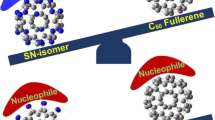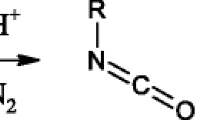Abstract
Quantum mechanical investigations are performed to show the mechanism and selectivity of Al8O12 nanocluster during different competing elimination reactions of acyclic and cyclic compounds. The studies reveal that, the nanocluster can selectively eliminate hydrogen halide in presence of both hydroxyl and halide as leaving groups. Furthermore, for competing dehydrohalogenations, the chemoselectivity trend is just opposite to the leaving character of the halides, i.e., the fluoride is eliminated first. The regioselectivity of the nanocluster is also remarkable during elimination. Most importantly, the dehydrohalogenations proceed through a so called ’unfavorable’ syn-elimination pathway thereby producing stereospecified products which are difficult to be produced via normal base catalytic condition.









Similar content being viewed by others
References
Tanabe K (1970) Solid acids and bases. Acad Press, New York
Ross JR (2011) Heterogeneous catalysis: fundamentals and applications. Elsevier
Wefers K, Misra C (1987) Oxides and hydroxides of aluminum. Alcoa Laboratories, Pittsburgh
Knözinger H (1968) Dehydration of alcohols on aluminum oxide. Angewandte Chemie Int Edn English 7(10):791–805
Fan D, Dai DJ, Wu HS (2012) Ethylene formation by catalytic dehydration of ethanol with industrial considerations. Materials 6(1):101–115
Jia W, Wu Q, Lang X, Hu C, Zhao G, Li J, Zhu Z (2015) Influence of lewis acidity on catalytic activity of the porous alumina for dehydrofluorination of 1, 1, 1, 2-tetrafluoroethane to trifluoroethylene. Catal Lett 145(2):654–661
DeWilde JF, Czopinski CJ, Bhan A (2014) Ethanol dehydration dehydrogenation on γ-al2o3 Mechanism of acetaldehyde formation. ACS Catal 4(12):4425–4433
Christiansen MA, Mpourmpakis G, Vlachos DG (2013) Density functional theory-computed mechanisms of ethylene and diethyl ether formation from ethanol on γ-al2o3 (100). Acs Catal 3(9):1965–1975
Busca G (1999) The surface acidity of solid oxides and its characterization by ir spectroscopic methods. An attempt at systematization. Phys Chem Chem Phys 1(5):723–736
Blumenfeld A, Fripiat J (1997) Acid sites topology in aluminas and zeolites from high-resolution solid-state nmr. Top Catal 4(1–2):119–129
Wischert R, Copéret C, Delbecq F, Sautet P (2011) Optimal water coverage on alumina: a key to generate lewis acid–base pairs that are reactive towards the c–h bond activation of methane. Angewandte Chemie Int Edn 50(14):3202–3205
Wischert R, Laurent P, Copéret C, Delbecq F, Sautet P (2012) γ-alumina: the essential and unexpected role of water for the structure, stability, and reactivity of ”defect” sites. J Am Chem Soc 134(35):14430–14449
Comas-Vives A, Schwarzwälder M, Copéret C, Sautet P (2015) Carbon–carbon bond formation by activation of ch3f on alumina. J Phys Chem C 119(13):7156–7163
Roy S, Mpourmpakis G, Hong DY, Vlachos DG, Bhan A, Gorte R (2012) Mechanistic study of alcohol dehydration on γ-al2o3. ACS Catal 2(9):1846–1853
Fang Z, Wang Y, Dixon DA (2015) Computational study of ethanol conversion on al8o12 as a model for γ-al2o3. J Phys Chem C 119(41):23413–23421
Wittbrodt J, Hase W, Schlegel H (1998) Ab initio study of the interaction of water with cluster models of the aluminum terminated (0001) α-aluminum oxide surface. J Phys Chem B 102(34):6539–6548
Kostetskyy P, Mpourmpakis G (2015) Structure-activity relationships in the production of olefins from alcohols and ethers: a first-principles theoretical study. Catal Sci Technol 5(9):4547–4555
Casarin M, Maccato C, Vittadini A (2000) Theoretical study of the chemisorption of co on al2o3 (0001). Inorgan Chem 39(23):5232–5237
Bermudez VM (2007) Quantum-chemical study of the adsorption of dmmp and sarin on γ-al2o3. J Phys Chem C 111(9):3719–3728
Biswas S, Pramanik A, Sarkar P (2016) Computational studies on the reactivity of alkyl halides over (al2o3) n nanoclusters: an approach towards room temperature dehydrohalogenation. Nanoscale 8:10205–10218
Liu X (2008) Drifts study of surface of γ-alumina and its dehydroxylation. J Phys Chem C 112(13):5066–5073
Fu Q, Wagner T, Rühle M (2006) Hydroxylated α-al2o3 (0001) surfaces and metal/ α-al2o3 (0001) interfaces. Surf Sci 600(21):4870–4877
Pistarino C, Finocchio E, Romezzano G, Brichese F, Di Felice R, Busca G, Baldi M (2000) A study of the catalytic dehydrochlorination of 2-chloropropane in oxidizing conditions. Indus Eng Chem Res 39(8):2752–2760
Bai S, Dai Q, Chu X, Wang X (2016) Dehydrochlorination of 1,2-dichloroethane over ba-modified al2o3 catalysts. RSC Adv 6(14):5618–5630
Lowry TH, Richardson KS (1981) Mechanism and theory in organic chemistry. Harper & Row, New York
Smith MB, March J (2007) March’s advanced organic chemistry: reactions, mechanisms, and structure. Wiley
Saunders WH, Cockerill AF (1973) Mechanisms of elimination reactions. Wiley-Interscience
Misono M, Yoneda Y (1972) Stereochemistry and isotope effect in the dehydrobromination of 2-bromobutane over solid catalyst. Chem Lett 7:551–552
Misono M (1973) Stereoselectivity of the elimination reactions of alkyl halides over silica gel and alkali-treated silica gel. J Catal 30(2):226–234
Misono M, Aoki Y, Yoneda Y (1976) Stereochemical studies of elimination reactions of 2-bromobutane and 2, 3-dibromobutane over alkali-ion exchanged silica gels. Bull Chem Soc Jpn 49(3):627–633
Misono M, Takizawa T, Yoneda Y (1978) Dehydrobromination of bromoalkanes over cabosil and alkali-ion-exchanged cabosils: I. A stereochemical study. J Catal 52(3):397–405
Lee JG, Bartsch RA (1979) Dehydrohalogenation by complex base. Preferential loss of” poorer” halogen leaving groups. J Am Chem Soc 101(1):228–229
Croft AP, Bartsch RA (1983) Complex-base-promoted syn eliminations from trans-1-bromo-2-chlorocyclohexane. J Org Chem 48(6):876–879
Croft AP, Bartsch RA (1994) Comparison of β-chloro-activated, syn and anti dehydrochlorinations induced by complex base. J Org Chem 59(7):1930–1932
Blanc EJ, Pines H (1968) Alumina: catalyst and support. xxxvii. Mechanism of dehydration of cis-and trans-2-alkyl-, 2-phenyl-and 3-tert-butylcyclohexanols over alumina catalysts. J Org Chem 33(5):2035–2043
Frisch MJ, Trucks GW, Schlegel HB, Scuseria GE, Robb MA, Cheeseman JR, Scalmani G, Barone V, Mennucci B, Petersson GA, Nakatsuji H, Caricato M, Li X, Hratchian HP, Izmaylov AF, Bloino J, Zheng G, Sonnenberg JL, Hada M, Ehara M, Toyota K, Fukuda R, Hasegawa J, Ishida M, Nakajima T, Honda Y, Kitao O, Nakai H, Vreven T, Montgomery JA Jr, Peralta JE, Ogliaro F, Bearpark M, Heyd JJ, Brothers E, Kudin KN, Staroverov VN, Kobayashi R, Normand J, Raghavachari K, Rendell A, Burant JC, Iyengar SS, Tomasi J, Cossi M, Rega N, Millam JM, Klene M, Knox JE, Cross JB, Bakken V, Adamo C, Jaramillo J, Gomperts R, Stratmann RE, Yazyev O, Austin AJ, Cammi R, Pomelli C, Ochterski JW, Martin RL, Morokuma K, Zakrzewski VG, Voth GA, Salvador P, Dannenberg JJ, Dapprich S, Daniels AD, Farkas, Foresman JB, Ortiz JV, Cioslowski J, Fox DJ (2009) Gaussian 09 Revision C.01, gaussian Inc. Wallingford CT
Zhao Y, Truhlar DG (2008) The m06 suite of density functionals for main group thermochemistry, thermochemical kinetics, noncovalent interactions, excited states, and transition elements: two new functionals and systematic testing of four m06-class functionals and 12 other functionals. Theor Chem Acc 120(1-3):215–241
Zhao Y, Truhlar DG (2006) A new local density functional for main-group thermochemistry, transition metal bonding, thermochemical kinetics, and noncovalent interactions. J Chem Phys 125(19):194101
Zhao Y, Truhlar DG (2008) Exploring the limit of accuracy of the global hybrid meta density functional for main-group thermochemistry, kinetics, and noncovalent interactions. J Chem Theory Comput 4(11):1849–1868
Sengupta T, Das S, Pal S (2015) Oxidative addition of the c–i bond on aluminum nanoclusters. Nanoscale 7(28):12109–12125
Ahubelem N, Altarawneh M, Dlugogorski BZ (2014) Dehydrohalogenation of ethyl halides. Tetrahedron Lett 55(35):4860–4868
Rosenbach N, Mota CJ (2005) A dft study of sn2 and e2 reactions of butylhalides on zeolite y: The effect of the leaving group. J Mol Struct Theochem 731(1):157–161
McQuarrie DA (2000) Statistical Mechanics. University Science Books, Sausalito
Boys SF, Bernardi Fd (1970) The calculation of small molecular interactions by the differences of separate total energies. Some procedures with reduced errors. Mol Phys 19(4):553–566
Evans MG, Polanyi M (1935) Some applications of the transition state method to the calculation of reaction velocities, especially in solution. Trans Faraday Soc 31:875–894
Eyring H (1935) The activated complex in chemical reactions. J Chem Phys 3(2):107–115
Canneaux S, Bohr F, Henon E (2014) Kisthelp: a program to predict thermodynamic properties and rate constants from quantum chemistry results. J Comput Chem 35(1):82–93
Foster J, Weinhold F (1980) Natural hybrid orbitals. J Am Chem Soc 102(24):7211–7218
Reed AE, Curtiss LA, Weinhold F (1988) Intermolecular interactions from a natural bond orbital, donor-acceptor viewpoint. Chem Rev 88(6):899–926
Lu T, Chen F (2012) Multiwfn: a multifunctional wavefunction analyzer. J Comput Chem 33(5):580–592
Yang W, Mortier WJ (1986) The use of global and local molecular parameters for the analysis of the gas-phase basicity of amines. J Am Chem So 108(19):5708–5711
Mendez F, Gazquez JL (1994) Chemical reactivity of enolate ions: the local hard and soft acids and bases principle viewpoint. J Am Chem Soc 116(20):9298–9301
House HO, Ro RS (1958) The stereochemistry of elimination reactions involving halohydrin derivatives and metals1. J Am Chem Soc 80(1):182–187
Cho S, Kang S, Keum G, Kang SB, Han SY, Kim Y (2003) Indium-mediated reductive elimination of halohydrins. J Org Chem 68(1):180–182
Bartlett PD (1935) Cis-and trans-chlorohydrins of cyclohexene1. J Am Chem Soc 57(1):224–227
Posner GH, Gurria GM (1976) Organic reactions at alumina surfaces. Elimination reactions effected by dehydrated chromatographic alumina. J Org Chem 41(3):578–580
Hudlicky M (1986) Dehydrohalogenations of cis-and trans-1-bromo-2-flourocyclohexanes. J Fluor Chem 32(4):441–452
Bunnett J (1962) The mechanism of bimolecular β-elimination reactions. Angewandte Chemie Int Edn English 1(5):225–235
Kobayashi T, Ohmiya H, Yorimitsu H, Oshima K (2008) Cobalt-catalyzed regioselective dehydrohalogenation of alkyl halides with dimethylphenylsilylmethylmagnesium chloride. J Am Chem Soc 130(34):11276–11277
Bartsch RA, Zavada J (1980) Stereochemical and base species dichotomies in olefin-forming e2 eliminations. Chem Rev 80(6):453–494
Stirling CJ (1979) Leaving groups and nucleofugality in elimination and other organic reactions. Acc Chem Res 12(6):198–203
Yamawaki J, Kawate T, Ando T, Hanafusa T (1983) Potassium fluoride on alumina. An efficient solid base for elimination, addition, and condensation. Bull Chem Soc Jpn 56(6):1885–1886
Kopka IE, Nowak MA, Rathke MW (1986) Dehydrohalogenation reactions using hindered lithium dialkylamide bases. Synth Commun 16(1):27–34
Acknowledgments
The financial supports from CSIR (F. No. 01(6762)/17) and UGC (F. No. 43-174/2014 (SR)), New Delhi, Govt. of India are gratefully acknowledged. A.P. expresses his sincere gratitude to Dr. N.A. Begum and Dr. A. Hazra, Dept. of Chemistry, Visva-Bharati for sharing their experiences in synthetic Organic Chemistry. A.P. also acknowledges Dr. D.S. Kothari Postdoctoral Fellowship provided by UGC, New Delhi, Govt. of India.
Author information
Authors and Affiliations
Corresponding authors
Ethics declarations
Conflict of interests
The authors declare no competing financial interest.
Electronic supplementary material
Below is the link to the electronic supplementary material.
Rights and permissions
About this article
Cite this article
Biswas, S., Pramanik, A. & Sarkar, P. Computational studies on the mechanism and selectivity of Al8O12 nanocluster for different elimination reactions. Struct Chem 28, 1895–1906 (2017). https://doi.org/10.1007/s11224-017-0974-3
Received:
Accepted:
Published:
Issue Date:
DOI: https://doi.org/10.1007/s11224-017-0974-3




